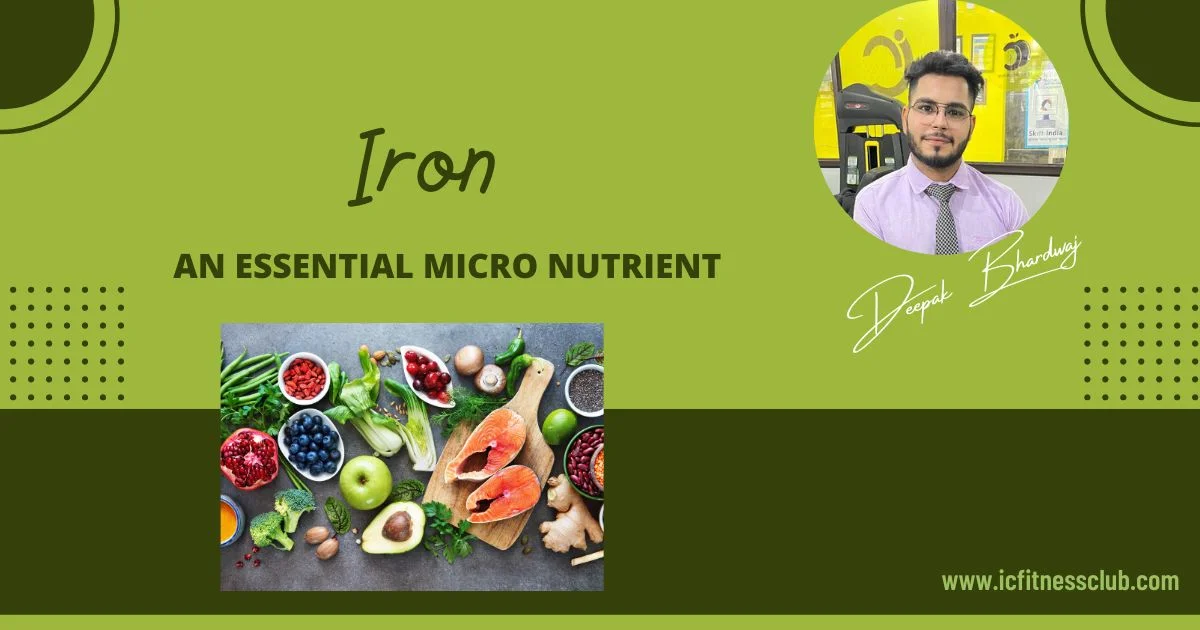Iron – An Essential micro Nutrient | IC Fitness Club
Iron is an essential nutrient that is important for many bodily functions. It is a mineral that plays a critical role in the production of hemoglobin, a protein in red blood cells that carries oxygen throughout the body. Iron is also important for immune system function, brain development, and the synthesis of some hormones.
Iron is found in both plant and animal sources, with animal sources generally being more readily absorbed by the body. Good sources of iron include red meat, poultry, fish, beans, lentils, tofu, fortified cereals, and dark leafy greens like spinach and kale.
Iron deficiency can lead to anemia, which can cause fatigue, weakness, and other symptoms. It is important to consume adequate amounts of iron in the diet or through supplementation, especially for individuals who are at risk for a deficiency, such as pregnant women, infants, and vegetarians or vegans who may not consume sufficient amounts of iron-rich foods.
Functions of Iron
Iron is an essential mineral that performs several critical functions in the body, including:
- Oxygen transport: Iron is a component of hemoglobin, a protein found in red blood cells that carries oxygen from the lungs to the body’s tissues and organs.
- Energy production: Iron is involved in the process of cellular respiration, which produces energy in the form of ATP (adenosine triphosphate) within cells.
- Immune system function: Iron is required for the proper functioning of the immune system. It helps white blood cells fight off infections and diseases.
- Brain function: Iron is important for the normal functioning of the brain. It is involved in the synthesis of neurotransmitters such as dopamine, norepinephrine, and serotonin, which play a role in mood, behavior, and cognitive function.
- Muscle function: Iron is essential for the proper functioning of muscles. It is involved in the production of myoglobin, a protein found in muscle cells that helps store and transport oxygen.
- DNA synthesis: Iron is required for the synthesis of DNA, the genetic material that carries the instructions for the development and function of all cells in the body.
Overall, iron plays a crucial role in several important bodily functions and is necessary for optimal health and well-being.
Types of Iron
There are two types of iron:
- Heme iron: Heme iron is found in animal-based foods such as red meat, poultry, and fish. It is easier for the body to absorb than non-heme iron, and it accounts for about 10-15% of the iron in the typical Western diet.
- Non-heme iron: Non-heme iron is found in both plant-based and animal-based foods, but it is primarily found in plant-based foods such as beans, lentils, fortified cereals, spinach, and tofu. It is harder for the body to absorb than heme iron, and it accounts for about 85-90% of the iron in the typical Western diet.
It is important to note that the absorption of non-heme iron can be enhanced by consuming it with a source of vitamin C, such as citrus fruits or tomatoes. Additionally, the absorption of both heme and non-heme iron can be inhibited by consuming certain compounds, such as calcium and tannins, which are found in foods such as dairy products and tea, respectively.
RDA of Iron
The Recommended Dietary Allowance (RDA) of iron varies depending on age, gender, and other factors such as pregnancy and lactation. Here are the RDAs of iron for different population groups:
- Infants (0-6 months): 0.27 milligrams per day (mg/day)
- Infants (7-12 months): 11 mg/day
- Children (1-3 years): 7 mg/day
- Children (4-8 years): 10 mg/day
- Children (9-13 years): 8 mg/day
- Males (14-18 years): 11 mg/day
- Females (14-18 years): 15 mg/day
- Males (19-50 years): 8 mg/day
- Females (19-50 years): 18 mg/day
- Males (51+ years): 8 mg/day
- Females (51+ years): 8 mg/day
- Pregnant females: 27 mg/day
- Lactating females: 9-10 mg/day
It is important to note that the RDA is the average daily intake level that is sufficient to meet the nutrient requirements of most healthy individuals in a specific age and gender group. However, some individuals may require more or less iron depending on their individual needs and health status. If you are unsure about your iron intake or have a health condition that affects iron absorption, you should consult a healthcare professional for personalized advice.
Iron and athletic Performance
Iron plays an important role in athletic performance because it is required for the production of hemoglobin, which carries oxygen to the muscles. Iron deficiency can lead to a decrease in hemoglobin levels and cause fatigue and reduced endurance in athletes. Here are some ways in which iron affects athletic performance:
- Oxygen transport: Iron is a key component of hemoglobin, the protein that carries oxygen in the blood to the muscles. Without enough iron, the body cannot produce enough hemoglobin, which can lead to decreased oxygen delivery to the muscles and reduced athletic performance.
- Energy production: Iron is also involved in the production of ATP (adenosine triphosphate), which is the primary energy source for muscle contractions during exercise. Iron deficiency can impair ATP production and lead to reduced endurance and fatigue.
- Recovery and immune function: Iron is necessary for proper immune function and recovery from exercise-induced muscle damage. Iron deficiency can impair the immune system and slow down recovery, which can hinder athletic performance.
Athletes, especially female athletes and those who participate in endurance sports, are at higher risk of iron deficiency due to increased iron loss through sweat, urine, and menstrual blood loss. Therefore, it is important for athletes to ensure adequate iron intake through a balanced diet that includes iron-rich foods such as red meat, poultry, fish, Meat and Eggs. If an athlete suspects they may be iron deficient, they should consult a healthcare professional for testing and treatment recommendations.





